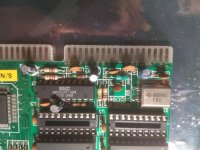Seeking Assistance with Paradise VGA card
Seeking Assistance with Paradise VGA card
I am seeking some help with a search to attain documentation or user recommendation for a Western Digital Paradise VGA 8-bit card and accompanying software found on line. The card has 256kB RAM and PVGA1A chip. I am using the card as replacement for the P4 card of an AT&T 6300 machine with standard 640 KB RAM. The P4 still works however the monochrome monitor bit the dust long ago. The P4 card has been disabled by use of the removal of the 74LS00 chip and shorting of the pins as described in the AT&T service manual. Right now, with the PVGA1A switch settings are OFF, I can see in color CGA, however, I am seeking VGA, if possible. Switch settings SW1-1 and SW1-2 allow for PS/2, which suggest VGA capability. However, I have yet to try them. There are four config files are listed ISAA201.CFG, ISAA201A.CFG, ISAA20FG, and ITCC0210.CFG. I would assume the ISAA201.CFG or ISAA201A.CFG is applicable to my PVGA1A card for the config.sys file. The executables are PARADISE.EXE, VESA.EXE, VESA1A1B.EXE, VESA1C.EXE, VESA1D.EXE, and VESAX.EXE. I have tried both PARADISE.EXE and VESA.EXE. Both put some commands in RAM. The assistance being sot would address the four config files, six executables and any switches associated with them along with which of the config files are associated with these executables.

